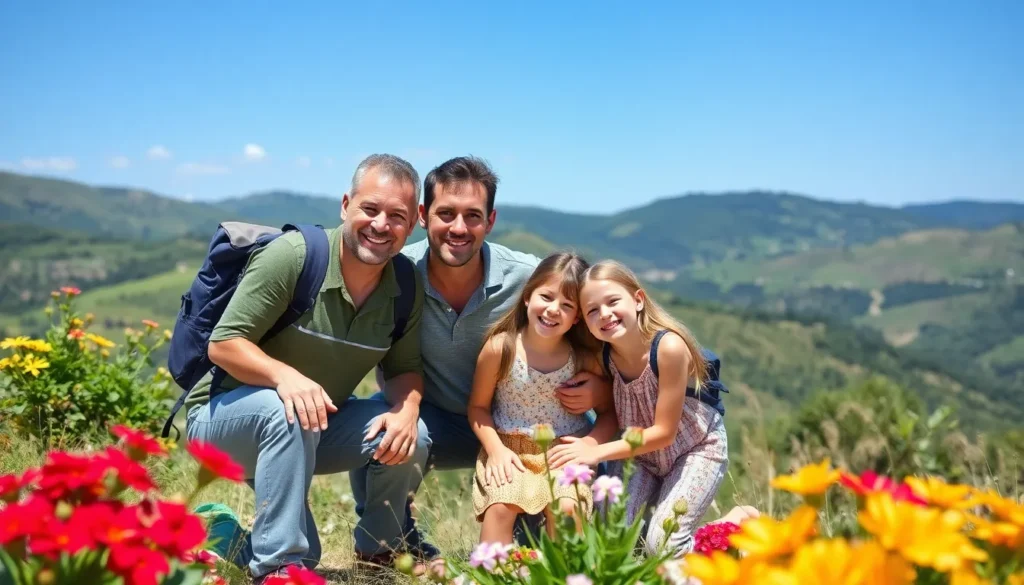Table of Contents
ToggleCapturing family adventures on camera can feel like herding cats—chaotic and often unpredictable. Yet, those candid moments of joy, laughter, and the occasional sibling squabble are what make travel memories truly special. With a few clever tips, anyone can transform their travel snaps from blurry chaos into stunning keepsakes that’ll have relatives asking for copies faster than you can say “cheese.”
Whether it’s the perfect sunset on a beach or a family portrait in front of a famous landmark, great travel photography doesn’t require a professional degree. With the right mindset and a sprinkle of creativity, anyone can become the family’s designated photographer. So grab that camera and get ready to turn your family trips into a visual storybook that will be cherished for years to come.
Essential Family Travel Photography Tips
Capture moments spontaneously. Families can enjoy the spontaneity of travel with candid shots that reflect genuine emotions. Look for unexpected interactions between family members during outings.
Choose the right time for outdoor photography. Early mornings and late afternoons offer softer lighting, enhancing photos’ quality. Natural sunlight during these times creates captivating images filled with warmth.
Utilize different angles and perspectives. Experimenting with varied viewpoints adds uniqueness to family pictures. Shoot from above, below, or even eye level to reveal different aspects of a scene.
Incorporate familial elements in compositions. Including family members in framing emphasizes their connection to the environment. Consider using leading lines, reflections, or interesting backgrounds to enhance the visual appeal.
Keep equipment lightweight and functional. Traveling families may benefit from compact cameras or smartphones for convenience. A simple setup allows easy transport without compromising quality.
Plan for group shots. While spontaneity is key, a few posed family portraits create lasting memories. Choose iconic backdrops or locations significant to family experiences for a more meaningful capture.
Encourage participation among family members. Children can have fun posing or taking turns with the camera. Engaging everyone fosters creativity and contributes to a variety of perspectives.
Edit images thoughtfully after the trip. Basic edits can enhance colors, adjust lighting, or crop distractions. This final touch can transform good photos into stunning keepsakes.
Preparing for Your Family Trip

Preparation is key for successful family travel photography. Focusing on the right gear and planning shots before departure helps capture meaningful moments.
Choosing the Right Gear
Select lightweight cameras or smartphones for ease during family adventures. Compact devices often deliver excellent quality without the burden of heavy equipment. Include additional batteries to avoid missing key moments due to power issues. Incorporate versatile lenses, if using a camera, to adapt to various environments. Packing a small tripod ensures stability for group photos or landscapes. Opt for weather-resistant gear if traveling to unpredictable climates. Utilize camera bags that allow quick access, enabling spontaneity in capturing genuine emotions.
Planning Your Shots
Scout stunning locations before arrival for optimal photo opportunities. Research best times to visit specific spots, ensuring ideal lighting conditions. Create a shot list that highlights must-have family images, such as candid moments and posed group shots. Encourage family members to suggest their favorite poses or backdrops for personal involvement. Visualize compositions beforehand, considering angles and perspectives that capture the essence of each setting. Remaining flexible allows for spontaneous shots that emerge during the trip, fostering authentic memories.
Capturing Candid Moments
Candid moments reveal the true essence of family adventures. They showcase genuine connections and joyful experiences, making travel photography meaningful.
Encouraging Natural Interactions
Encouragement fosters authentic interactions among family members. Use prompts to inspire spontaneous activities, like playing a game or exploring new surroundings together. Offer assistance with tasks that allow for shared experiences, such as setting up a picnic. Keep the atmosphere relaxed and playful to cultivate comfort and enthusiasm for the camera. Avoid posing everyone directly, as this can lead to stiff images. Instead, capture moments as they unfold, allowing personalities to shine. Use humor to elicit genuine smiles and laughter, then let the camera record these real connections.
The Art of Timing
Timing plays a crucial role in candid photography. Anticipate moments that often arise during family activities, such as joyous reactions to exciting events or playful interactions between siblings. Golden hour, which occurs shortly after sunrise and before sunset, provides soft lighting ideal for warm, inviting photographs. Pay attention to the surrounding environment for unexpected opportunities, like children discovering a hidden treasure. Utilizing burst mode on a camera can help capture split-second moments, preventing the loss of vital emotions. Patience is key; observing scenes allows for timely clicks that result in natural, striking images.
Composition Techniques for Family Photos
Composition plays a crucial role in capturing memorable family photographs. Applying effective techniques enhances visual storytelling and emotional depth.
Rule of Thirds
Using the rule of thirds makes images more dynamic. Imagine dividing the frame into a 3×3 grid. Placing subjects along these lines or at their intersections creates balanced compositions. For family portraits, positioning family members according to this guideline draws attention to them without overwhelming the scene. It can also guide the viewer’s eye through the photograph, emphasizing the relationship between subjects and their surroundings.
Leading Lines and Framing
Incorporating leading lines directs the viewer’s focus to the main subjects. Natural elements, like roads, fences, or paths, can create an inviting pathway into the frame. Framing the family within natural elements enhances visibility while adding depth. Use trees, windows, or archways to create visual interest. These techniques not only establish context but also narrate a family’s journey, making the story more engaging. By connecting lines and frames, the composition transforms family moments into captivating visual experiences.
Post-Processing Your Images
Post-processing enhances family travel photos, making them more vibrant and engaging. This phase is where images transform into cherished keepsakes.
Basic Editing Techniques
Start with cropping to eliminate distractions and focus on subjects. Adjust brightness and contrast to enhance clarity, allowing colors to pop and details to stand out. Fine-tune saturation for richer tones, while maintaining natural skin colors. Use sharpening tools to improve image clarity, creating defined edges for a polished look. Consider applying filters or presets for stylistic consistency across your collection. Lastly, save images in high resolution to preserve quality for prints or digital sharing.
Organizing Your Photos
Arranging photos systematically simplifies the review process. Create folders categorized by date or location, making it easy to locate specific images. Utilize software that offers tagging features to label photos with keywords related to events or subjects. Implement a star rating system to highlight favorite shots, enabling quick access to the best images. Regularly back up files to prevent loss and ensure security. Collaboration with family on organization encourages shared memories and collective decision-making regarding selections.
Family travel photography is a rewarding way to capture the essence of shared adventures. By focusing on candid moments and employing thoughtful techniques, families can create stunning visual memories that last a lifetime. Embracing creativity and flexibility allows for authentic captures that reflect true emotions.
With the right preparation and mindset, anyone can enhance their photography skills without needing professional equipment. From experimenting with angles to involving family members in the process, each step contributes to a richer storytelling experience. Ultimately, these photographs serve as cherished reminders of the joy and connection found in family travels.





